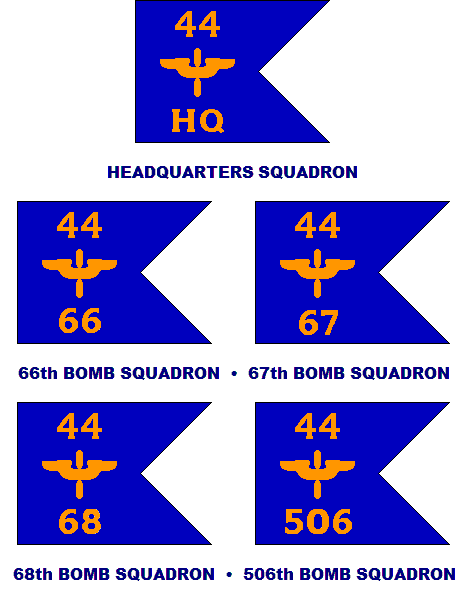Headquarters, US Army Air Forces (USAAF)
was the command responsible for all Army air operations during World War II. It
embodied the US Army Air Corps (USAAC) plus all the various support units
(antiaircraft artillery, engineer, military police, medical, supply, etc.)
required to sustain air operations. Thus the USAAF was an operational command
headquarters, while the USAAC was an Army branch. Gradually, the USAAC's
functions were assumed by HQ, USAAF and by war's end its existence as an Army
branch was purely formal. The USAAF, on the other hand, had become an
independent component of the armed forces in all but name.
The branch
colors of the USAAC were ultramarine blue and golden orange; these colors were
also used for USAAF flags. Higher formations, such as numbered air forces,
generally displayed the authorized shoulder sleeve insignia (SSI) on their
distinguishing flags. Operationally, numbered air forces were the senior field
headquarters, equivalent to a corps; under them came commands, air divisions, wings and
groups. USAAF distinguishing flags were made of wool bunting, 3 feet at
the hoist by 4 feet on the fly. They
were always carried or displayed with a National Standard, Service,
made of wool bunting,
3 feet at the hoist by 4
feet on the fly
plus 2 1/2-inch yellow silk fringe.
The group,
usually composed of three or four squadrons, was the color-bearing echelon of
the USAAC. Organizational standards for groups were of the standard Army
pattern, made of silk, 3 feet at the hoist by 4 feet on the fly, plus 2 1/2-inch
fringe. The field of the standard was ultramarine blue and the fringe was golden
orange. USAAC squadrons and companies had guidons of the standard Army pattern,
with the group designation above and the squadron or company designation below
the branch insignia. Guidons were made of wool bunting, 20 inches at the hoist
by 27 3/4 inches on the fly with a 10-inch fork. The field was ultramarine blue;
numerals, letters and insignia were golden orange.
The
Commanding General, USAAF, was authorized a silk color. Dimensions were 4 feet 4
inches at the hoist by 5 feet 6 inches on the fly plus 2 1/2 inch fringe. The
field was ultramarine blue and the fringe was golden orange. Centered on the
color was the USAAF SSI with its ultramarine blue disk indistinguishable against
the flag's field. The SSI was flanked by four stars denoting the Commanding
General's rank. A field flag version of the color was also authorized.
Other general officers assigned to the staffs of the USAAF and the USAAC were
authorized field flags, with stars according to rank. For major
generals, the stars flanked the insignia as shown; for brigadier generals, one
star was placed above the insignia. Field flags were made of wool
bunting, 3 feet at the hoist by 4 feet on the fly.
Note:
Active links in descriptions point to the flags and guidons of
subordinate organizations.
Credit:
The
drawings on this page are based on the specifications given in Army Regulation 260-10
dated 25 October 1944, a copy of which was kindly provided by FOTW Mailing List member
Joseph McMillan.
Images
Added December 2006
Seventh
Air Force •
Fifteenth Air Force
|
